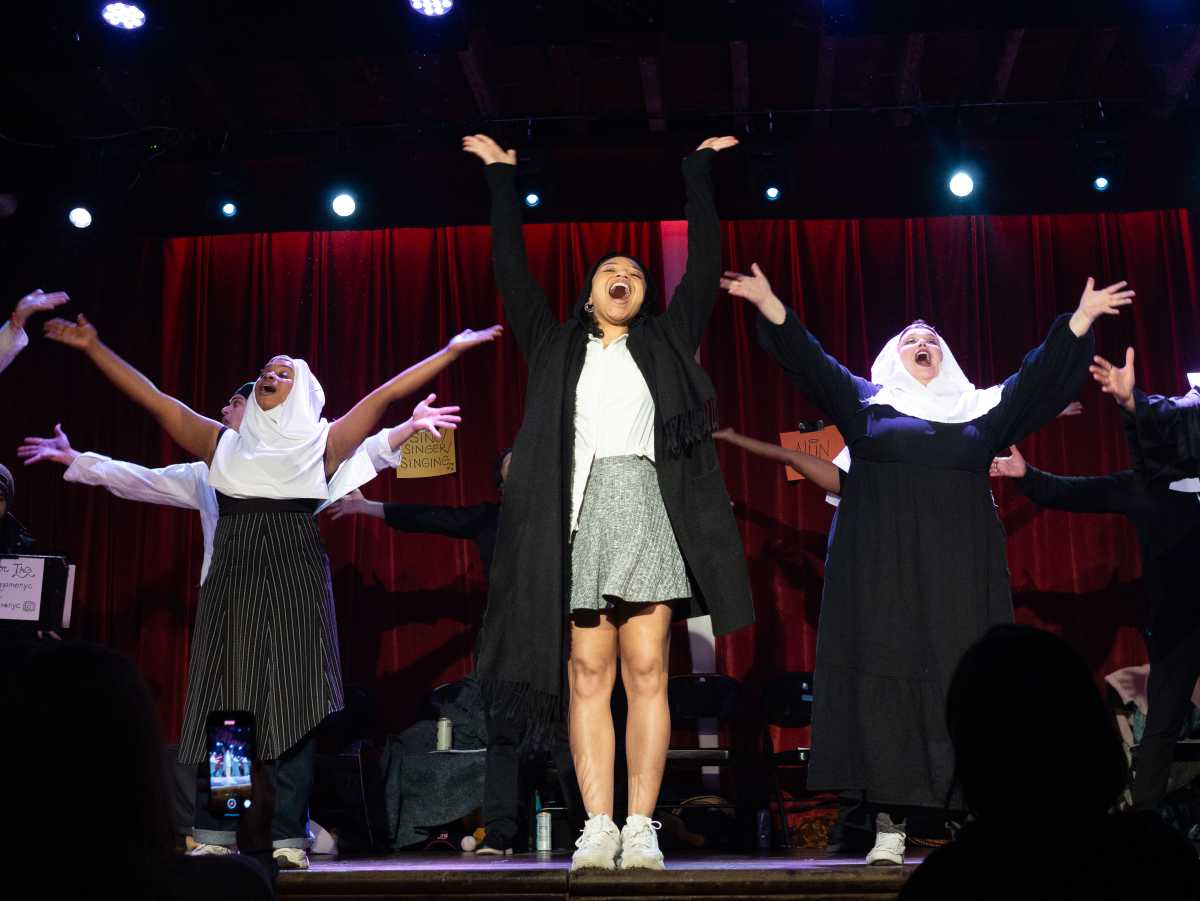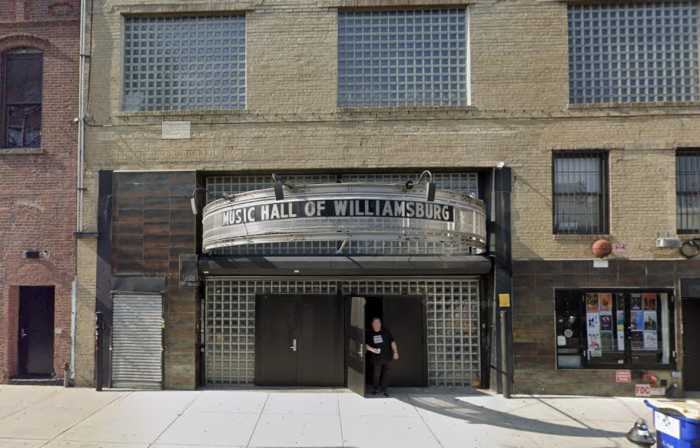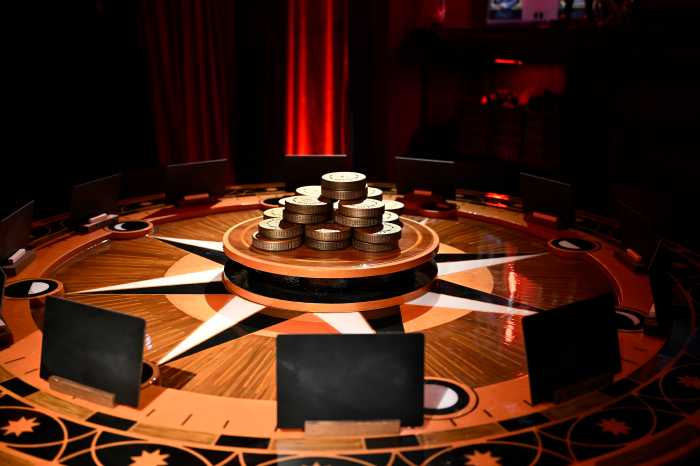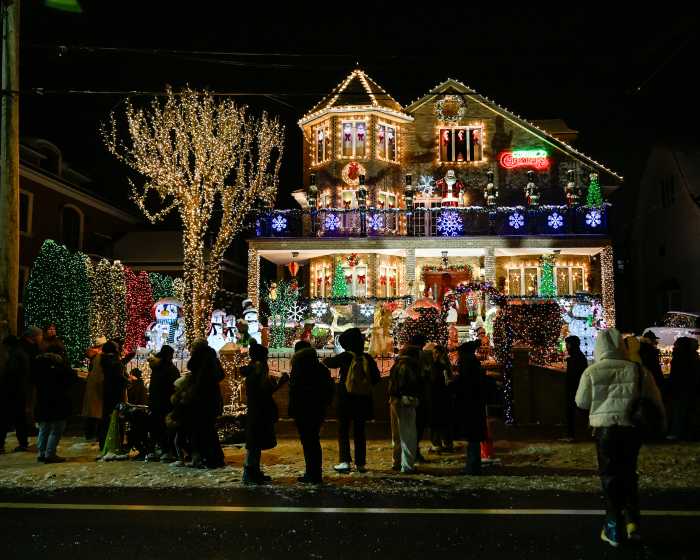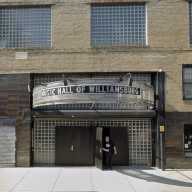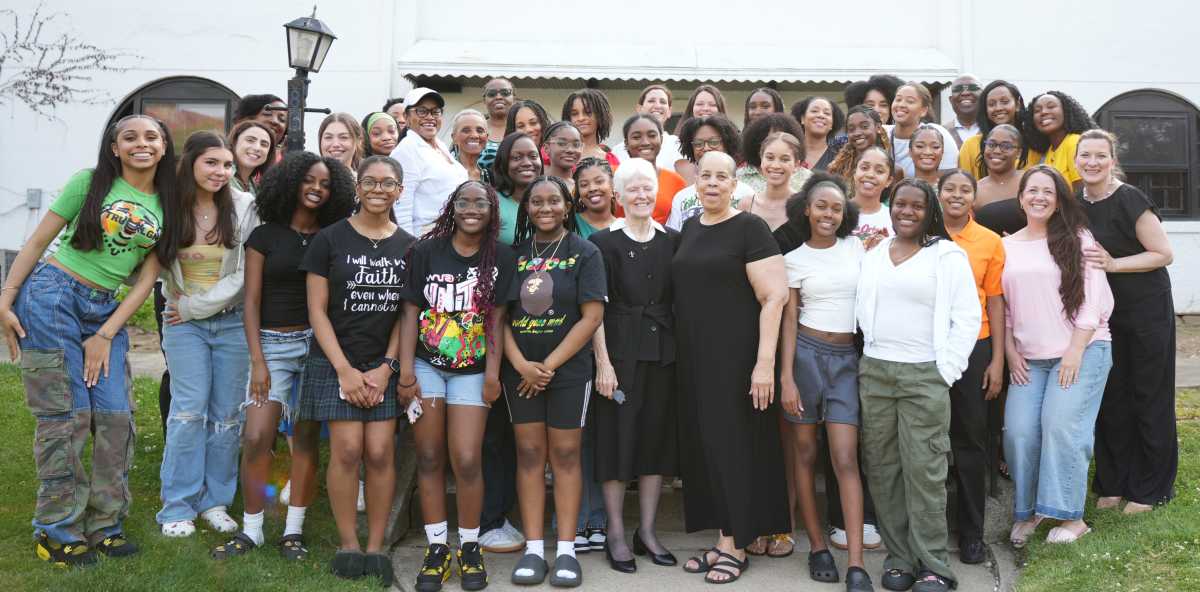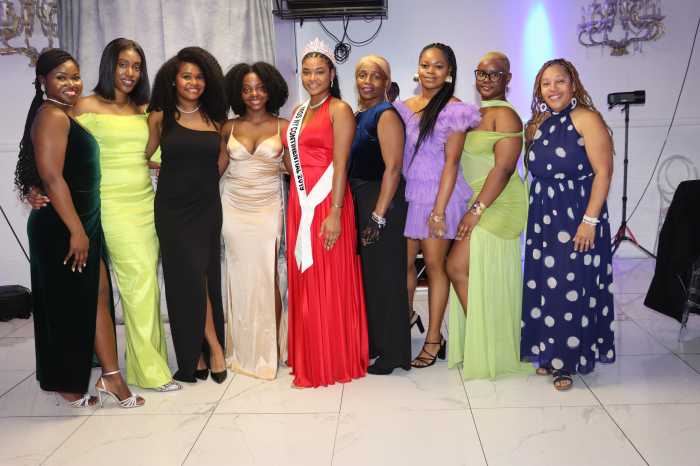People aren’t usually supposed to talk during shows — but on a recent Saturday night in Brooklyn, the audience at The Bell House shouted “take off your robes!” along with the actor on stage.
As the song “Joyful, Joyful” started to play, an actor slid across the floor to perform a backspin and headstand. The cast tossed away makeshift choir robes, ran onstage, and broke into the upbeat, hip-hop-inspired dance from “Sister Act 2″ under vibrant, multi-color stage lights. The audience danced too, and many of them sang along. Nearly everyone was drunk — performers included — so they weren’t worried about looking silly. They were having fun.
Once a month, A Drinking Game NYC reenacts beloved 80s, 90s, and 00s films as live performances at The Bell House, a large bar and former warehouse in Gowanus, while playing a drinking game with the audience. During stage adaptations of movies like “10 Things I Hate About You,” “Hocus Pocus,” “Beetlejuice,” “Moulin Rouge,” “Back to the Future,” and “Shrek,” the actors and audience take a sip of an alcoholic beverage every time they hear the specified recurring drinking words, as many as a cumulative 200 times. Audience members also have the option to abstain or drink non-alcoholic beverages.
In typical A Drinking Game fashion, the board and cast developed their production of “Sister Act 2″ in roughly two weeks with few resources aside from talent and creativity. Though they are skilled comedians, actors, and artists, the comedy troupe also draws from the spirit of high school theater: Their shows are handmade, quirky, and not too serious.
“We have five minutes, and we have two dollars,” joked Calandra Daby, the show’s director.
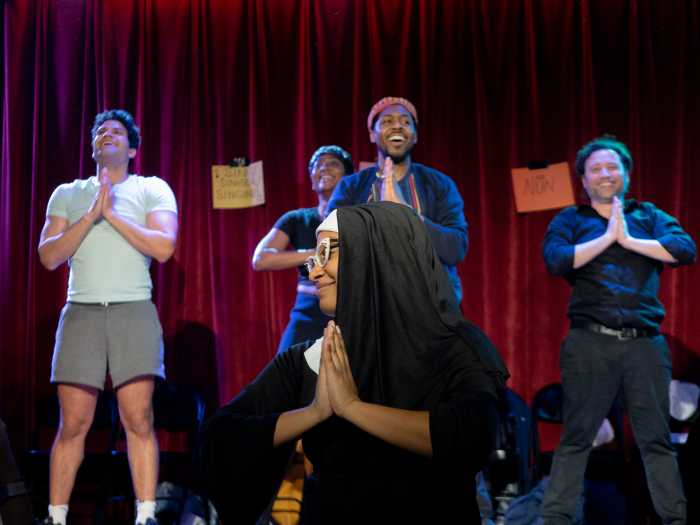
At the production meeting, she suggested using T-shirts and pillowcases for nun costumes; rain ponchos, graduation gowns, and “the fabric we already have” for choir robes; and a kazoo for a piano prop. “We reuse past things,” said Meghan Ballback, props designer. “It’s about realizing this is a silly, fun thing we’re putting on.”
For their reenactment of “Jurassic Park,” cast members held two fans behind a person with a water bottle to portray an acid-spitting dinosaur. During a nude scene in “Titanic,” an actor wore a T-shirt with a funny sketch of a naked body. They use a bubble gun for snow, and a floor scooter — the kind from elementary school gym class — represents any sort of unusual transportation, from futuristic hoverboards to superhuman flight.
“The whole point is we’re kind of a ragtag team,” Daby said. “It isn’t polished. It’s like a sleepover.”
A few days before “Sister Act 2,” the troupe met for a read-through at a friend’s art gallery near Sunset Park. Sitting in a circle, they read the script in their roles, figured out finicky details for the performance, and selected drinking words for the night: “nun,” “sister” and “sing.”
Daby doled out quirky ideas: She directed one actor to portray curtains, another actor to portray a baseball, and two actors to portray an elevator. The group embraced the whimsy, hamming up the sit-down read-through with silly voices, physical gags, and impressions of the actors in the 1993 film. After the read-through, the cast rehearsed the dance choreography together for the first time, and they continued until 10:30 p.m..
“It’s such a labor of love from everyone involved. We just started paying ourselves last year,” Daby said. “This is hours a month.”
On the day of “Sister Act 2,” the cast met mid-afternoon for a rehearsal at The Bell House, blocking the show for the first and only time. Daby’s precise, thorough direction kept the rehearsal quick and productive, but there still wasn’t enough time to run every scene or finalize every detail. “If it’s not perfect, do it with confidence,” Ballback said.
Later that evening, audience members filled The Bell House, and a “buzz” started to emerge.
“What I always notice with most if not all shows is the buzz. The buzz in the room,” said Stephanie Marrow, the actor in the lead role. “You’ll always remember the feeling — and I just remember being like, ‘I am so happy, and I am having so much fun.’”
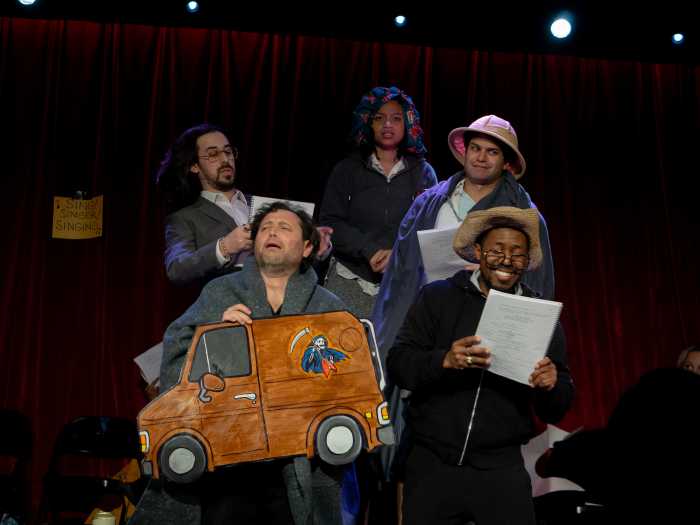
After a selection of funny pre-show videos about nuns and choirs from “Saturday Night Live” to “The Simpsons,” company member Chopper Jacobs introduced himself as the narrator. In addition to the drinking words — which were posted on the stage curtain — he announced that the performers would take a sip every time they heard their characters’ names. Then, A Drinking Game’s reenactment of “Sister Act 2″ began.
“It’s easy to see what we do as a little bit frivolous, but I think there is true acting value in it: You’re always navigating how much to honor the script and how much to make it your own,” Jacobs said. “Rather than just getting onstage and goofing off, you have to put a lot of thought into the moment you’re seizing.”
The troupe tries to stay faithful to the movies so the audience can recognize their favorite moments and quote lines out loud with the performers — but some of the most exciting parts of the show drew from the cast’s comedic impulses, like Eric Lockley’s over-emphasized lines as the crotchety Latin teacher, Lindley Key’s dialogue with herself as two different characters, and Marrow’s mention of Doechii despite the 1993 setting.
“The movies that they pick are cult classics where you know a lot of the lines,” said Ashley Szwec, a five-time audience member. “It’s different from watching it together in a movie theater. It’s funnier. Their improv during some of the lines adds to the experience.”
During “Sister Act 2,” the cast and audience cheerfully sipped their drinks in unison at every drinking word. When performers forgot to drink at the mention of their characters’ names, the audience called them out on it. At one point, an actor repeated “mama” nearly a dozen times at once, an ad lib to encourage the actor playing her mother to chug her drink.
“We’re trying to capture the spirit of just playing a drinking game with a couple of your friends where you just pick up a couple of beers and go for it,” Jacobs said.
The cast became discernibly drunk, which added to the goofiness. After a character was asked for his name, the actor struggled to answer the question because he lost his place in his script. When a pair of actors mistakenly watched a scene for which their characters were supposed to be absent, the actor center stage ad libbed “who’s out there?” and earned unanticipated laughs.
Nonetheless, getting drunk isn’t the point of the game: Rather than an experiment with inebriation, A Drinking Game aims to create a laid-back, interactive experience to engage everyone in the room. The boozy game prevents the cast from taking themselves too seriously and invites the audience to participate in the fun as more than observers.
“The fact that they make it a game makes it a group activity,” Szwec said. “A communal act, a shared experience with the drinking words.”
“It almost makes you feel like you have some sort of camaraderie with the people onstage, like you’re all in on this funny joke,” said Anne-Marie Collopy, another audience member, about the drinking game.
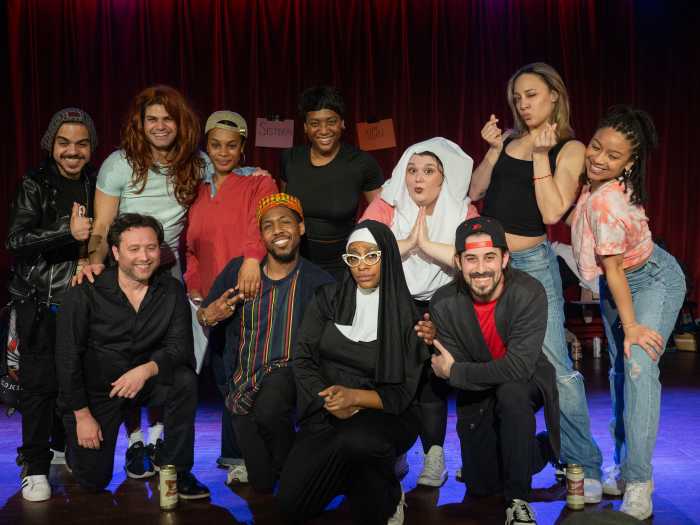
Some audience members don’t drink alcohol at all: Eric Berkeley, a seven-time audience member, participates with water. “Whether you’re drinking an alcoholic beverage or not, you can still go to A Drinking Game and just have fun,” he said. “It’s a very fun back-and-forth between the audience and the performers, and that’s always a great experience. It makes the audience feel like they’re part of the show too.”
After the show, the troupe and audience stayed at The Bell House for a post-show party. The mingling, dancing, and lively atmosphere made it clear why they love the ridiculously comical, super-drunk, nostalgic game: It’s about the shared, palpable joy created in the space, a product of the troupe’s dedicated, deliberate work.
“We’re serious about what we do, and we’re serious about the product we bring to the audience,” Marrow said. “But chaotic and fun, that’s our core.”
There isn’t a consensus about the exact nature of A Drinking Game. Board, company, and audience members described it as “comedy and parody,” “interactive theater,” “drink-along, sing-along, quote-along,” “part impression, part improv, definitely part party,” and “DIY madness.”
Whatever it is, it’s very Brooklyn: creative, unconventional, and community-focused at heart.


